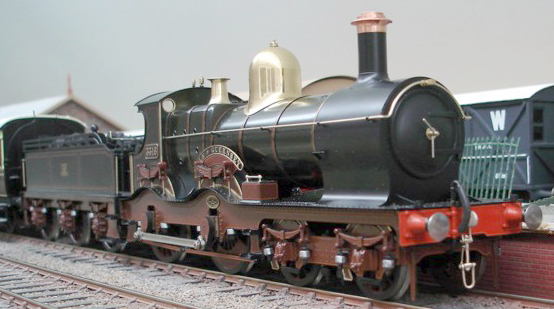|
|
|
|
This is a 7mm scale model built by Lee Marsh from the Finney kit - the 4mm version builds up to produce a similar model |
|
|
Ref |
Specification |
Price |
To complete |
|
|
L25 |
Etched nickel silver frames, motion and brass superstructure Lost wax, whitemetal and turned fittings Flexichas suspension Non-working, ‘dummy’ inside motion Designed by Martin Finney Kit to convert to working Inside Motion - IM25 |
£175 |
Dean 2500 gallon tender, Dean 3000 gallon tender or Churchward 3500 gallon tender. |
|
|
Wheels |
Driving: 5'8" 18-spoke outside crank - Ultrascale, Alan Gibson, Markits Bogie: 3'8" diameter 10-spoke - Ultrascale, Alan Gibson, Markits |
|||
| Motor | Designed for a Mashima 1024 | |||
| Gearbox | High Level Load Hauler Plus | |||
| Download the instructions | View the etches |
|
The kit contains alternative parts to enable construction of an accurate model from circa 1900 to the withdrawal of the last member of the class in 1951. Both the original condition with narrow cabs and those rebuilt with wide cabs are covered. Included are two chimneys, top feed, five alternative cabs, two different bogies a choice of round top (S4) or Belpaire (B4) boilers and the ATC equipment. |
|
|
Variations/Modifications incorporated into the kit |
|
|
Outside frames: In original condition the outside frames had mostly flush rivets. Soon, after visits to the shops, snap head rivets begin to appear. From 1904 about half of the engines received frame strengthening plates around the horns with some also acquiring tie bars. Balance weights: A bewildering variety - all the different permutations are included. Coupling rods: Originally fluted. Replacement rods from c.1908 onwards were of plain section. Bogies: Originally of the swing hanger type with shallow frames, with splasher beading and the small lower splashers. Many replaced with deeper frames. Some were rebuilt to 'De Glehn' type without swing hangers and fitted with strengthening patches. Small footplate steps: Eight small steps were fitted to the platform, two in front of each splasher from an unknown date. Boilers: As shown above most were built with a S4 boiler having a flush round top firebox. The last of these boilers was removed from 3279 in 1917. From 1903 new standard domed Belpaire (type B4) boilers were fitted. Chimneys: Originally copper capped without a capuchon. Soon a capuchon was fitted. At an unknown date the chimney was moved forward. From 1920 cast iron tapered chimneys were introduced for replacements. Boiler feed: Lots 97, 101, 102 & 105 were built with very large clackboxes which are not provided in the kit. Lot 113 were built with the smaller clackboxes supplied with the kit. Photographs suggest many of the earlier engines were soon fitted with the smaller clackboxes. The B4 boilers fitted from 1903 had the clackboxes fitted on the backplate inside the cab. From 1913 onwards, about half of the boilers had the boiler feed moved from the backplate to a position in front of the dome on the top of the boiler. |
Smokebox: The early smokeboxes had a plain front with a square front edge and ringed door. Later snap head rivets were used and from c.1920 the smokeboxes had a pressed front with a rounded front edge and Churchward type door without the ring. Cabs: The original cabs were very narrow and fitted with a canvas covered wooden roof. Many of the Dukes were given large wire cabs when first fitted with B4 Belpaire boilers, others at various times thereafter. These wide cabs were fitted with steel roofs with two patterns of rain strip. Most of the wide cabs had standard Churchward windows, but several had wider ‘L’ shaped windows. The small circular windows above the firebox were blanked off after about 1926. When fitted with standard Churchward 3500 gallon tenders from 1930 the cab side sheets were set outwards at the back. Those not fitted with wide cabs when fitted with B4 boilers initially retained the original low cabs. The larger firebox necessitated the fitting of very small cab windows which clearly provided a less than satisfactory forward view. This problem was subsequently overcome by raising the roof of the narrow cabs to allow the fitting of larger windows. They also received new steel roofs with two patterns of rain strip. Cab side handrails: The original narrow cabs had no side handrails. When the cab roofs were raised handrails were fitted. The wide cabs had handrails in at least three different positions. Beading: Much of the decorative beading from the splashers and bogies was removed during the Great War (c. 1914 - 1918). A.T.C. equipment: Put on all but 3252/7/9/62/77 between 1930 and 1931. Vacuum pipe: Originally tall - later a shorter pattern introduced. Whistles: In their last years, a few of the engines had their whistles removed from the cab roof to a position on top of the firebox and some acquired a whistle shield. |
|
Variations/Modifications not incorporated into the kit Boilers: The domed, raised Belpaire BR4 boilers fitted to 3312 and 3328-31 when built are not provided. After the usual transfer to other members of the class the last of these was removed from 3291 in 1913. Ten engines, at one time or another, carried dome less boilers with raised Belpaire fireboxes (type BR0). The last of these was removed from 3278 in 1929. From 1926 five engines (3254/69/71/72/79) had the boiler pitch increased by 5” to accommodate a new pattern of piston valve cylinders. |
TENDERS: Lots 97, 101, 102 & 105 were built with very small tenders of 2000 gallon capacity. Larger 2500 gallon tenders were fitted to Lot 113. Later most were paired with standard Dean 2500 gallon or 3000 gallon tenders. From around 1930 many of the class acquired standard Churchward 3500 gallon tenders.
|
